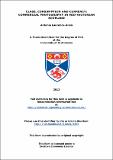Files in this item
Class, consumption and currency : commercial photography in mid-Victorian Scotland
Item metadata
| dc.contributor.advisor | Normand, Tom | |
| dc.contributor.author | Laurence-Allen, Antonia | |
| dc.coverage.spatial | 2 v. | en_US |
| dc.date.accessioned | 2013-04-05T10:03:01Z | |
| dc.date.available | 2013-04-05T10:03:01Z | |
| dc.date.issued | 2012-11-30 | |
| dc.identifier | uk.bl.ethos.570541 | |
| dc.identifier.uri | https://hdl.handle.net/10023/3469 | |
| dc.description | Electronic version excludes material for which permission has not been granted by the rights holder | en_US |
| dc.description.abstract | This thesis examines a thirty year span in the history of Scottish photography, focusing on the rise of the commercial studio from 1851 to assess how images were produced and consumed by the middle class in the mid-Victorian period. Using extensive archival material and a range of theoretical approaches, the research explores how photography was displayed, circulated, exploited and discussed in Scotland during its nascent years as a commodity. In doing so, it is unlike previous studies on Scottish photography that have not attended to the history of the medium as it is seen through exhibitions or the national journals, but instead have concentrated on explicating how an individual photographer or singular set of images are evidence of excellence in the field. While this thesis pays close attention to individual projects and studios, it does so to illuminate how photography functioned as a material object that equally shaped and was shaped by ideological constructs peculiar to mid-Victorian life in Scotland. It does not highlight particular photographers or works in order to elevate their standing in the history of photography but, rather, to show how they can be used as examples of a class phenomenon and provide an analytical frame for elucidating the cultural impact of commercial photography. Therefore, while the first two chapters provide a panoramic view of how photography was introduced to the Scottish middle class and how commercial photographers initially visualized Scotland, the second section is comprised of three ‘case studies’ that show how the subject of the city, the landscape and the portrait were turned into objects of cultural consumption. This allows for a re-appraisal of photographs produced in Scotland during this era to suggest the impact of photography’s products and processes was as vital as its visual content. | en_US |
| dc.language.iso | en | en_US |
| dc.publisher | University of St Andrews | |
| dc.rights | Creative Commons Attribution-NonCommercial-NoDerivs 3.0 Unported | |
| dc.rights.uri | http://creativecommons.org/licenses/by-nc-nd/3.0/ | |
| dc.subject | Photography | en_US |
| dc.subject | Scotland | en_US |
| dc.subject | Commerce | en_US |
| dc.subject | Class | en_US |
| dc.subject | Victorian | en_US |
| dc.subject | History | en_US |
| dc.subject.lcc | TR690.L2 | |
| dc.subject.lcsh | Commercial photography--Scotland--History--19th century | en_US |
| dc.subject.lcsh | Photography--Social aspects--Scotland--History--19th century | en_US |
| dc.subject.lcsh | Middle class--Scotland--History--19th century | en_US |
| dc.subject.lcsh | Material culture--Scotland--History--19th century | en_US |
| dc.title | Class, consumption and currency : commercial photography in mid-Victorian Scotland | en_US |
| dc.type | Thesis | en_US |
| dc.contributor.sponsor | Arts and Humanities Research Council (AHRC) | en_US |
| dc.type.qualificationlevel | Doctoral | en_US |
| dc.type.qualificationname | PhD Doctor of Philosophy | en_US |
| dc.publisher.institution | The University of St Andrews | en_US |
| dc.rights.embargoreason | Thesis restricted in part in accordance with University regulations. Images in electronic copy restricted permanently. | en_US |
This item appears in the following Collection(s)
Except where otherwise noted within the work, this item's licence for re-use is described as Creative Commons Attribution-NonCommercial-NoDerivs 3.0 Unported
Items in the St Andrews Research Repository are protected by copyright, with all rights reserved, unless otherwise indicated.



